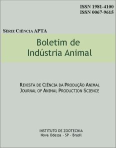Comparison between chemical and surgical castration on performance
Abstract
The essay was developed at the Estação Experimental de Zootecnia de São José do Rio Preto, State of São Paulo, Brazil, using 51 crossbreed Santa Gertrudis young bulls raised in grazing regime, in "pangola"-grass, "estrela"-grass, "batatais"-grass and "jaraguá"-grass paddocks. The animals were born in the second bimester of 1978 and 1979, and were arranged in a complete randomized design with three treatments and 8 and 9 replications in the first and second years, respectively. The treatments: CC = surgical castration, CQ = chemical castration and NC = checks. The animals of the chemical treatment received one intra-testicular shot of a 40% formic aldehyde solution plus additives and had fever only in the day after the shot day. The surgical treatment animals had fever form the second until the eightieth day after the surgery. It was not statistical difference between treatments for live weight gains but the difference between years was statistical significant. It was concluded that the chemical castration in cattle would be advised when the animals are to be slaughtered elder. Besides the simplicity, the chemical castration is less demaged and presents less jot surgery problems.
Downloads
Downloads
Published
Issue
Section
License
Os autores não serão remunerados pela publicação de trabalhos, pois devem abrir mão de seus direitos autorais em favor deste periódico. Por outro lado, os autores ficam autorizados a publicar seus artigos, simultaneamente, em repositórios da instituição de sua origem, desde que citada a fonte da publicação original seja Boletim de Indústria Animal. A revista se reserva o direito de efetuar, nos originais, alterações de ordem normativa, ortográfica e gramatical, com vistas a manter o padrão culto da língua e a credibilidade do veículo. Respeitará, no entanto, o estilo de escrever dos autores. Alterações, correções ou sugestões de ordem conceitual serão encaminhadas aos autores, quando necessário. Nesses casos, os artigos, depois de adequados, deverão ser submetidos a nova apreciação. As opiniões emitidas pelos autores dos artigos são de sua exclusiva responsabilidade. Todo o conteúdo deste periódico, exceto onde está identificado, está licenciado sob a Licença Creative Commons Attribution (CC-BY-NC). A condição BY implica que os licenciados podem copiar, distribuir, exibir e executar a obra e fazer trabalhos derivados com base em que só se dão o autor ou licenciante os créditos na forma especificada por estes. A cláusula NC significa que os licenciados podem copiar, distribuir, exibir e executar a obra e fazer trabalhos derivados com base apenas para fins não comerciais.













